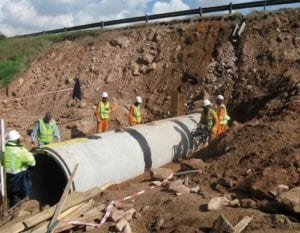Most people associate roads and road building with asphalt. However, those involved with road design know that precast concrete also plays an indispensable role in road construction. Can you elaborate?
JC Any road, be it a suburban byway or a national freeway, can be built entirely with concrete and suburban roads can be and often are completely built with precast concrete. There are six product categories in which precast concrete is used:
• paving and kerbs
• water management products such as pipes, culverts, kerb inlets, grating, manholes, and embankment down drains
• columns, beams, slabs and barriers for bridges
• retaining walls, security walls, soundproofing walls and barriers
• poles and masts for electricity reticulation and lighting
• a general category for products such as such as bus shelters, bollards, lay-bys, security boxes and toilets.
There are several reasons for this. Unlike other materials, which deteriorate with age, concrete gains strength, requires little, if any, maintenance, and has a life expectancy in excess of 50 years. Unlike asphalt, which is imported and subject to periodic shortages and rising costs, the elements which constitute concrete can all be locally sourced. Why precast concrete in particular?
Perhaps the biggest benefit of precast concrete is that it is much faster to use than its insitu equivalent. Precast concrete has the added advantage of being manufactured in controlled factory environments where SABS standards and ISO 9000 management systems ensure a consistently high quality. The sourcing and production of raw materials, as well as the installation of precast concrete products, is labour intensive, which is very important in South Africa. Locally, there is an abundance of the raw materials required for its manufacture, as well as more than enough installed manufacturing capacity to meet the demands of any accelerated infrastructure programmes. Gauteng’s freeway system recently underwent a major revamp. What role did precast concrete play in the Gauteng Freeway Improvement Project? During construction, SANRAL project manager Hennie Kotze said that the space for staging and shuttering support was often extremely limited, which meant that the use of precast concrete elements such as beams on bridges was indispensable to the upgrading process. In addition, stormwater pipes and box culverts had to be extended under the freeways and in instances where new interchanges were built, new culvert and stormwater systems using precast concrete pipes and rectangular culverts were installed. It was also the first time that precast concrete highway barriers were used extensively, replacing W-section crash barriers. Precast concrete panellingwas used for embankment reinforcing and facades. Precast beams, which varied from small I-beams to huge U-beams, were also used on the project.
It appears that municipal engineers still tend to favour asphalt as their default paving material. However, an increasing number of roads are being paved with concrete block paving (CBP). Why is this?
Sustainability, poverty alleviation and safety are the main drivers here. CBP was first introduced to this country 50 years ago when it was used to pave roads in the Durban township of Chatsworth. However, it was not until the advent of the new millennium that CBP was taken seriously as a suburban road-paving alternative.
Laying roads with CBP is labour-intensive and offers the unemployed an opportunity of acquiring a marketable skill and earning capacity. The income earned has a multiplier effect, stimulating economic activity in other sectors of local communities. Could you describe how CBP contributes to greater safety?
The chance of aquaplaning on wet surfaces is greatly reduced with CBP roads. The two-to-three-millimetre water sheet often found on asphalt roads during heavy downpours is virtually non-existent, especially when the pavers are bevelled. One may find an isolated water channel crossing a CBP road but not water sheeting over an extended area. Permeable paving installations, which are specifically designed to soak up stormwater, are even more effective at dispersing surface water and can be installed on sections of road where water channels are likely to form. CBP also offers better braking owing to its rough texture and broken surface. In addition, it provides better road marking with coloured and luminous concrete pavers and offers constant and maintenance-free signage.








